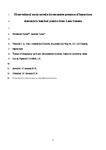Observational Study Unveils the Extensive Presence of Hazardous Elements in Beached Plastics from Lake Geneva
| dc.contributor.author | Filella, M | |
| dc.contributor.author | Turner, Andrew | |
| dc.date.accessioned | 2018-04-04T15:06:32Z | |
| dc.date.available | 2018-04-04T15:06:32Z | |
| dc.date.issued | 2018-02-02 | |
| dc.identifier.issn | 2296-665X | |
| dc.identifier.issn | 2296-665X | |
| dc.identifier.other | ARTN 1 | |
| dc.identifier.uri | http://hdl.handle.net/10026.1/11230 | |
| dc.description.abstract |
Over 3,000 samples of plastic litter have been retrieved from 12 pebble beaches around the shores of Lake Geneva. The plastic stock consisted of identifiable objects of various size and color, including bottles, bottle tops, cotton buds, pens, toys, and straws, an heterogeneous assortment of fragments whose origin was either discernible or unknown, and pieces or blocks of expanded polymer (polystyrene or polyurethane foam). Analysis of 670 samples by portable x-ray fluorescence (XRF) spectrometry revealed high concentrations of hazardous elements or compounds among many plastics. These included Cd, Hg, and Pb (with maximum concentrations of 6,760, 810, and 23,500 ppm, respectively) as stabilizers in PVC-based materials and/or brightly-colored sulfide or chromate pigments in primary and secondary plastics, and Br (with a maximum concentration of 27,400 ppm) as a proxy for brominated flame retardants (BFRs) in both plastics and foams. The abundance of hazardous elements in beached plastics that have been restricted or banned reflect the age and residence time of the plastic stock in the lake, coupled with a relatively high length of shoreline to surface area of the system. The migratability of hazardous elements from the polymeric matrix is likely to determine their environmental impacts and is recommended as a future area of research. | |
| dc.format.extent | 1- | |
| dc.language.iso | en | |
| dc.publisher | Frontiers Media SA | |
| dc.subject | Lake Geneva | |
| dc.subject | beaches | |
| dc.subject | plastics | |
| dc.subject | portable-XRF | |
| dc.subject | hazardous elements | |
| dc.subject | Hg | |
| dc.subject | Pb | |
| dc.subject | Cd | |
| dc.title | Observational Study Unveils the Extensive Presence of Hazardous Elements in Beached Plastics from Lake Geneva | |
| dc.type | journal-article | |
| dc.type | Journal Article | |
| plymouth.author-url | https://www.webofscience.com/api/gateway?GWVersion=2&SrcApp=PARTNER_APP&SrcAuth=LinksAMR&KeyUT=WOS:000452098800001&DestLinkType=FullRecord&DestApp=ALL_WOS&UsrCustomerID=11bb513d99f797142bcfeffcc58ea008 | |
| plymouth.issue | FEB | |
| plymouth.volume | 6 | |
| plymouth.publication-status | Published online | |
| plymouth.journal | Frontiers in Environmental Science | |
| dc.identifier.doi | 10.3389/fenvs.2018.00001 | |
| plymouth.organisational-group | /Plymouth | |
| plymouth.organisational-group | /Plymouth/Faculty of Science and Engineering | |
| plymouth.organisational-group | /Plymouth/Faculty of Science and Engineering/School of Geography, Earth and Environmental Sciences | |
| plymouth.organisational-group | /Plymouth/REF 2021 Researchers by UoA | |
| plymouth.organisational-group | /Plymouth/REF 2021 Researchers by UoA/UoA07 Earth Systems and Environmental Sciences | |
| plymouth.organisational-group | /Plymouth/Research Groups | |
| plymouth.organisational-group | /Plymouth/Research Groups/BEACh | |
| plymouth.organisational-group | /Plymouth/Research Groups/Marine Institute | |
| plymouth.organisational-group | /Plymouth/Users by role | |
| plymouth.organisational-group | /Plymouth/Users by role/Academics | |
| dc.identifier.eissn | 2296-665X | |
| dc.rights.embargoperiod | Not known | |
| rioxxterms.versionofrecord | 10.3389/fenvs.2018.00001 | |
| rioxxterms.licenseref.uri | http://www.rioxx.net/licenses/all-rights-reserved | |
| rioxxterms.type | Journal Article/Review |


